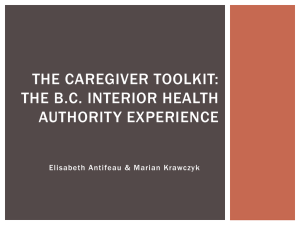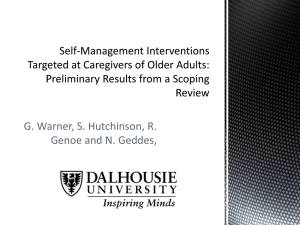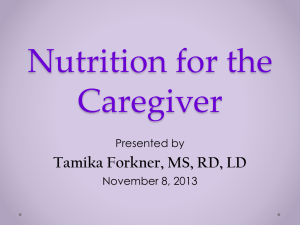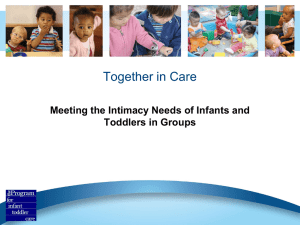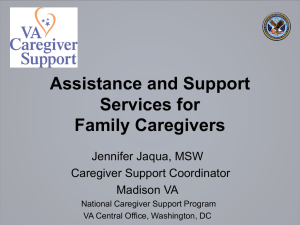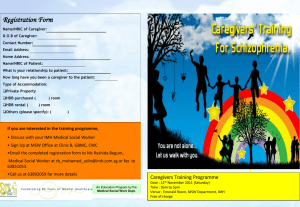PowerPoint-Employe-Satisfaction-Are-You
advertisement
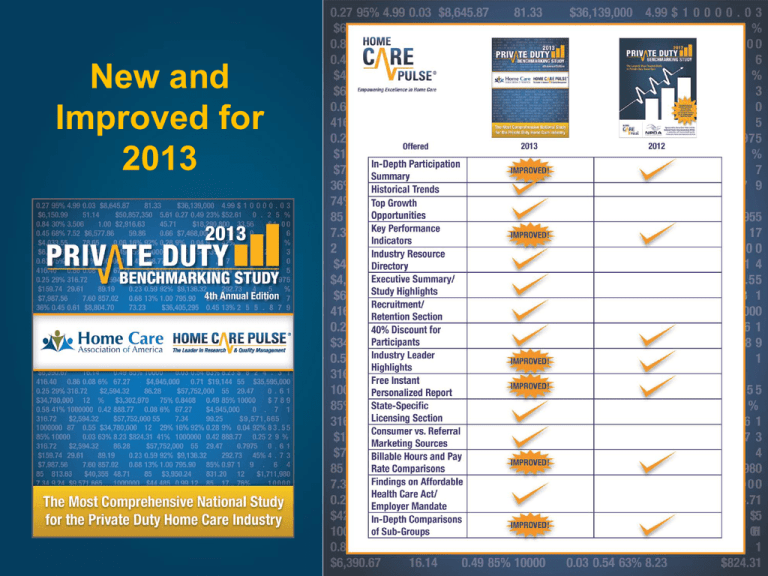
New and Improved for 2013 Are You Keeping Score? Part 2 Understanding The Numbers Behind Caregiver Satisfaction Ratings A Customer Mastery Webinar Presentation by, Aaron Marcum, Founder of Home Care Pulse Housekeeping » Everyone is on mute. » IMPORTANT – For the best quality audio, we suggest using your telephone and not your computer’s microphone. » Type your questions in the question box, and we will address them at the end of the call. » Please “be present” today, pretend we are in a classroom together. » Please take the one question survey when leaving the presentation. » The slides and recording of this presentation will be made available within 24 hours. Look for our email. Get the details at www.homecarepulse.com/awards About Aaron Marcum Today’s Agenda » Top Recruiting & Training Sources. » Explore and discuss how you can improve Caregiver Satisfaction Scores in final 5 Categories: 1. 2. 3. 4. 5. Office support staff and communication. Client/caregiver compatibility. Overall job satisfaction. Recommend employment. Recommend company’s services. » Explore and discuss how you can produce a happier Client . » Let’s Take a Poll – Quality Management Tenure. Reminder: The Quality Satisfaction Management Meeting » Hold at least once a month. » Include all members of your support team! » Take time to plan! » Focus on the feedback. » Sandwich the negative between the positives. » Make an action list. » Sample agenda posted in the “Resource” tab. The Power of Caregiver Perceptions The Filthy Airline Tray » What virus am I going to catch from touching this? » If they don’t clean the trays, what else don’t they clean? » This airline must not pay attention to detail. » Are they maintaining the critical equipment that keeps this thing in the air? The Science Behind The Scores » Promoters (Score 9-10): Loyal enthusiasts who will keep using your services and refer others, fueling growth! » Passives (Score 7-8): Satisfied but unenthusiastic, and vulnerable to higher wages, etc. » Detractors (Score 0-6): Unhappy caregivers who can damage your brand and impede growth through negative word-of-mouth. Improving the “Perception” of Office Support Staff and Communication » Latest Best of Home Care® Benchmark – 9.03 » Feedback Red Flags » 10 – “The office provides very frequent communication through mail, email or telephone.” » 8 – “Whenever I need to talk to the office staff they are always available and information is passed on well.” » 6 – “The communication could be improved by having more help in the office to cover all of the situations that arise.” » 5 – “There have been quite a few miscommunications.” Effectively Communicate with Professional Caregivers » Face-to-face, phone, email, text, newsletters, social media (company updates and announcements via Twitter, Facebook, etc.). » Communicate schedule changes, policy changes, announcements, training opportunities. » Timely communication. » Open and Honest Communication. » Create a Caregiver Position Agreement . (Contact leah@homecarepulse.com for a sample position agreement.) Basic Communication Model from “Managing Employee Communications” by Lloyd M. Field 1. Communicate goals, objectives and company accomplishments. 2. Communicate job responsibilities and performance standards. 3. Communicate individual performance review. 4. Recognize employee’s needs and concerns. 5. Create an upward communication component that reinforces the employee’s sense that he or she is valued by the company. Positive Communication/ Employee Recognition » 30% of caregivers surveyed by Home Care Pulse say when it comes to recognition for a job well done, they prefer verbal recognition by their supervisors. » Encourage managers/supervisors to focus on positive communication. » Recognize employees in private and in public. How Do Caregivers Like to Be Recognized? Top 5 Ways Caregivers Prefer to be Recognized 30.4% 29.0% 15.9% Verbal Recognition by Supervisor Pay Raise Recognition by Client 12.5% 12.2% Vacation Time, Bonuses, Perks, Gifts Cards Company Wide Recognition *Data based on thousands of caregiver satisfaction interviews performed by Home Care Pulse “Even the smallest moments of positivity in the workplace can enhance efficiency, motivation, creativity and productivity. One way to do this is simply to provide frequent recognition and encouragement . . . In fact, when recognition is specific and deliberately delivered, it is even more motivating than money.” --Shawn Achor in “The Happiness Advantage” Ideas for Caregiver Recognition » Send a “Thank You” note to 10% of your employees each month. » Friday phone calls. » Monthly newsletter mentioning positive recognition of employees. » Employee of the month program. » Pass on positive feedback from clients. » Educate your key managers on how to recognize…provide them with a “recognition budget.” -Caregiver Mentor ProgramA Communication Bridge++ 1. Select your best (experienced, loyal, stable and caring) caregivers to mentor new caregivers for a certain period of time. 2. Organize teams of caregivers and mentors. Mentors have weekly coaching calls with caregivers. 3. Structure the program. Outline rules. 4. Train all mentors. 5. Compensate mentors and new caregivers who participate in the program. 6. Promote the program. Improving the “Perception” of Client/Caregiver Compatibility » Latest Best of Home Care® Benchmark – 9.00 » Feedback Red Flags » 10 – “The agency is aware of my qualifications, so they match me with clients who could benefit from that experience.” » 8 – “They try their best to match us based upon our personalities as well as the client's needs.” » 6 – “They basically just match the client with any caregiver that is available.” » 5 – “They put me with a client whom I had no experience with, and they gave me no instructions.” “Finding great caregiver/client matches can often be the difference between a short and long [business] relationship. And long relationships equal big profits . . . Strong client/caregiver relationships also frequently lead to better relationships between the agency and the client's family.” --Jason Tweed, for Private Duty Today Matching Clients with Caregivers Client • Medical needs • Physical needs • Home environment • Personality • Gender • Language • Availability Caregiver • Qualifications • Physical ability • Work environment • Personality • Gender • Language • Availability Compatibility (continued) » Technology: utilize scheduling software. » Address compatibility problems quickly. – Listen to caregiver and client feedback. – Act on the results from Home Care Pulse’s Quality Satisfaction surveys. – Make caregiver safety a priority. – Make changes if necessary. Improving the “Perception” of Overall Job Satisfaction » Latest Best of Home Care® Benchmark – 9.00 » Feedback Red Flags » 10 – “My overall job satisfaction is high because they have provided me with steady work, enough hours and a fair pay rate.” » 9 – “My job satisfaction is pretty high because I really enjoy what I do. I really love my clients.” » 7 – “I like the job; I just don't get paid enough.” » 5 – “I am not happy because I do not have enough hours.” Overall Job Satisfaction Involves all aspects of the job: – Communication – Salary and benefits – Employee recognition – Work hours and location – Work environment – Client/caregiver compatibility – Training/growth opportunities Six Factors for Creating an Ideal Workplace from Jacob, Bond, Galinsky and Hill for the “Psychologist Manager Journal” 1. Job autonomy. Freedom, independence, discretion and flexibility when it comes to completing assigned work. 2. Learning opportunities. Opportunities to learn new things and influence what happens on the job. 3. Supervisor support for job success. Information on how to perform well in a job. Recognition of good job performance. Support with work problems. Six factors (continued) 4. Coworker team support for job success. “The feeling that one is really a part of the group and that coworkers provide the support needed to do a good job.” 5. Involvement in management decision making. Having managers at a workplace who actively seek out information and new ideas from employees at all levels of the organization to guide their decision making. 6. Workplace flexibility. “Flexibility in when and where work is done has consistently predicted better work relations and job commitment, whereas low levels of flexibility have predicted higher employee turnover.” Improving the “Perception” of Recommend Employment » Latest Best of Home Care® Benchmark – 9.23 » Feedback Red Flags » 10 – “I have already recommended a few friends to work for this agency.” » 8 – “I would recommend someone to work for this agency because they seem to be able to satisfy their employees.” » 6 – “They pay the lowest on the pay scale, so I wouldn't want my friends to work here.” » 5 – “I don't want anyone to go through this.” “Candidates recommended by employees tend to be better qualified than others. That's because employees pre-screen candidates, saving HR professionals time and money. Plus, employees bring an extra level of expertise to the recruitment process that recruiting firms cannot. They give candidates the low-down on the company culture — both the good and the bad — so new recruits come in with eyes wide open.” --Society for Human Resource Management/Referral Networks Employee 300 friends & acquaintances 300 friends & acquaintances 90,000 people who are friends of friends of employees From SHRM/Referral Networks Employees as Promoters » Satisfied employees will promote your business by referring friends and family to job openings and by recommending your business to prospective clients. » What is your Caregiver Engagement Score? » Promoters (Score 9-10): Loyal caregivers who thoroughly enjoy working for you and have no hesitation referring others to do the same! » Passives (Score 7-8): Satisfied caregivers, but are unenthusiastic and vulnerable to higher wages and other benefits. » Detractors (Score 0-6): Unhappy caregivers who can damage your client relationships and impede growth through negative word-of-mouth. Caregiver Engagement Score Calculation: – (% of Promoters - % of Detractors) = Caregiver Engagement Score – For Example: • Total of 20 Caregivers Interviewed: 16 Promoters, 2 Passives, & 2 Detractors. • % of Promoters = 80% • % of Detractors = 10% • (80% - 10%) = 70% • Net Promoter Score = 7.0 (Passive Score) Caregiver Engagement Score (continued) » Purpose: – Helps raise the bar and keep all key team members focused on caregiver recognition and other retention techniques. – Sends the message to the entire team that you cannot afford to have “detractors” or “passives.” – To focus attention on what you are doing right/wrong…not what the caregiver themselves! » Challenge: – Invalid if you ask this question and measure CES on your own. Promotes biased responses. – Caregivers MUST be anonymous and have no fear of retribution. – Must be consistent with a large enough sampling. Benefits of Referrals from SHRM/Referral Networks » Lower your cost per hire. » Provide a steady stream of high-caliber candidates who are often hard to find. » Increase employee retention by 25%. » Boost overall employee morale. » Foster positive communication among employees as well as to the outside world. Characteristics of an Effective Employee Referral Program by Joseph Slavin, general manager of Referrals, Inc. 1. Start at the top. Everyone in the company should be on board. 2. Keep rules to a minimum. Create simple steps for referrals and rewards. 3. Let everyone participate. Every employee, even management, should be involved. 4. Involve and reward outsiders. Include referrals from former employees (alumni) and clients. 5. Give VIP status to resumes. Employee referrals should be given top priority/contacted first. Characteristics (continued) 6. Let employees track progress. Employees should be able to check on the status of the referral. Notify employee of the status/interview/hiring of a referral. 7. Make it easy to refer. Job postings should be available to employees. Provide online tools for employees to “click” and refer. 8. Promote Constantly. Provide company-wide communication about job openings and successful referrals. Promote the referral program through new employee orientation, company handbook, interoffice communication, company intranet, email or brochures. Characteristics (continued) 9. Pay a decent bonus. Cash, gifts, raffle, event tickets, paid time off. 10. Pay it fast. Options for paying rewards: – – – – – Pay a predetermined amount for any referral. Pay all at once after a period of tenure (3 months, 6 months, one year). Spread the reward out over time (some at hire, some later). Pay all at once at the employees first day of work. Pay as a percentage of the new hire’s salary. » 10 – “I actually keep brochures Improving the “Perception” of Recommend Company Services » Latest Best of Home Care® Benchmark – 9.49 » Feedback Red Flags with me, so I can hand them out to people who are interested in receiving care.” » 9 – “I would recommend our company’s services because we do a good job of providing care to those in need.” » 7 – “I would only recommend the company's services with reservations.” » 5 – “I wouldn't recommend this agency for home care because I know there are problems.” The Problem » If your own caregivers won’t recommend your company’s services, you are losing out on a top marketing resource. » If caregivers see problems go unsolved or unaddressed, they are less likely to recommend your services. » A negative manager or supervisor may give the caregiver a bad impression of the entire company. » Caregivers may worry about other caregiver’s qualifications or lack thereof. The Solution Build caregiver confidence in your company and in other caregivers: » Communicate with your caregivers. » Promptly address their concerns and work to solve any problems. » Promote and encourage training opportunities. » Promote employee interaction through company gettogethers, newsletters, etc. » Educate caregivers about your policies and procedures. » Train your managers/supervisors. » Involve caregivers in creating new policies and procedures. “To win customers— and a bigger share of the marketplace —companies must first win the hearts and minds of their employees.” --Gallup In Summary » Communicate with your caregivers. » Be positive—recognize employees for a job well done. » Begin a caregiver mentor program. » Strive to match clients with the right caregiver. » Create an ideal workplace for your caregivers. » Promote an employee referral program. » Turn your caregivers into enthusiastic promoters of your business. New and Improved for 2013 The 2013 Study »2013 Edition! »Order now by going to privatedutybenchmarking.com. »Attendees receive a special discount of $70 by using code: LOYALTY13 Employer of Choice Awards » Awarded to 110 agencies nationally for the first time ever in July 2013. » Sets your agency apart as a top employer with nationally acclaimed caregiver job satisfaction ratings. » 10 Award Categories. » Qualifications: – Interview 10% of caregivers monthly. – Must average at least 2 interviews per month. – Rank in the top 50th percentile for one or more caregiver satisfaction categories. 2013 Winners: bestofhomecare.com/2013-employer-of-choice 1. 2. 3. 4. 5. Overall Job Satisfaction Recommend Employment New hire training Continued Training Comfort Talking with Direct Supervisor 6. Respected by Supervisor 7. Job Expectations 8. Communication from Office Support Staff 9. Client/Caregiver Compatibility 10. Recommend Company Services Quality Satisfaction Program: www.homecarepulse.com Andrew Rail Director of Quality Management andrew@homecarepulse.com (877) 307-8573 Private Duty Benchmarking Study: www.privatedutybenchmarking.com Connect with us on Social Media Facebook.com/homecarepulse @HomeCarePulse Questions? Jack LaBaugh, Director of Marketing & Public Relations jack@homecarepulse.com Andrew Rail, Director of Quality Management andrew@homecarepulse.com or (877) 307-8573 © Copyright 2013 Home Care Pulse, LLC



